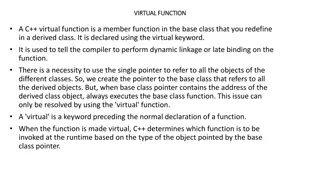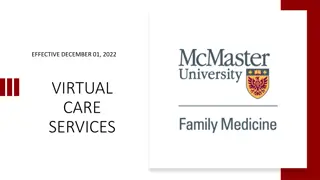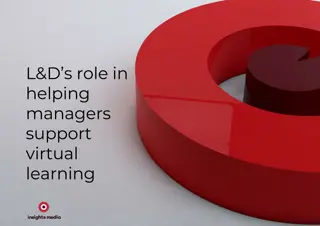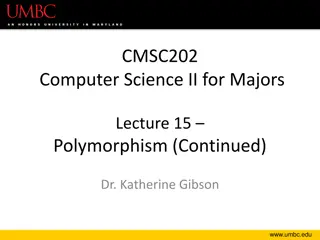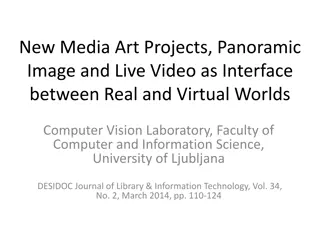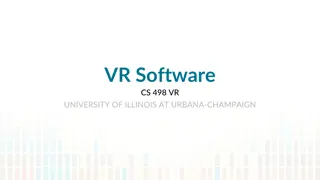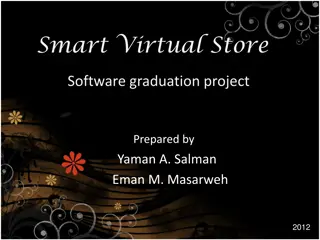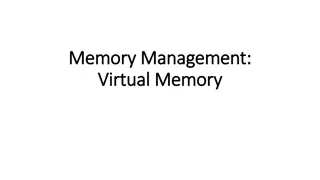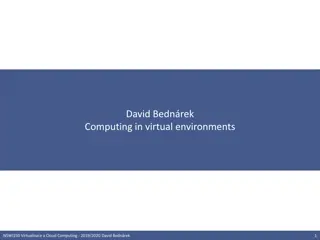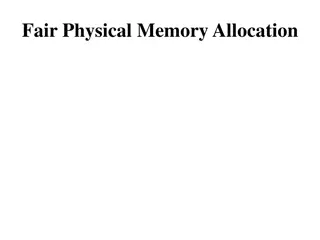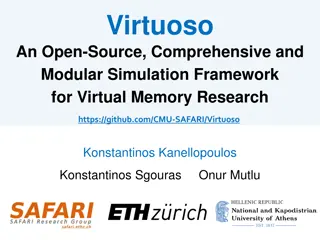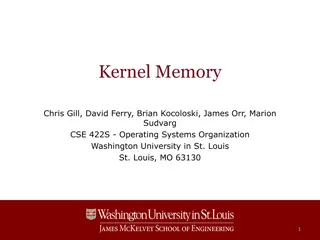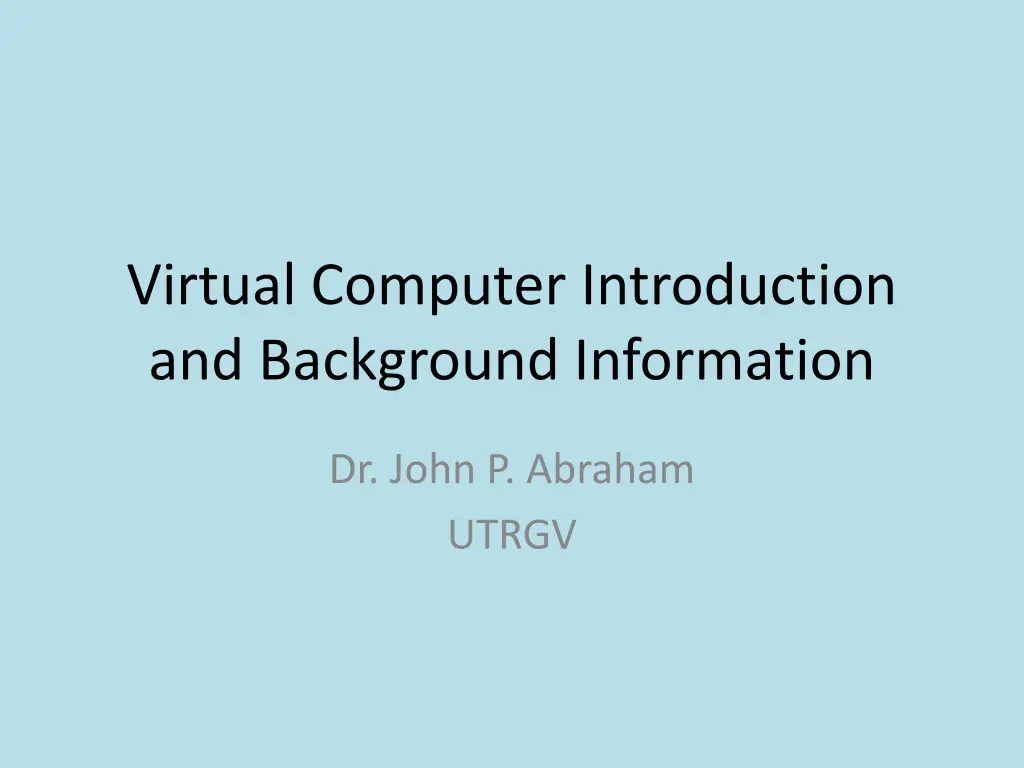
Understanding Virtualization Technology in Computing
Explore the concept of virtualization in computing, comparing single machine environments to virtual machines. Learn about the benefits, lifecycle, and different approaches to virtualization. Discover how virtual machines can allocate CPU, memory, and storage pools. Dive into the world of virtual infrastructure management and virtual machine lifecycles.
Download Presentation

Please find below an Image/Link to download the presentation.
The content on the website is provided AS IS for your information and personal use only. It may not be sold, licensed, or shared on other websites without obtaining consent from the author. If you encounter any issues during the download, it is possible that the publisher has removed the file from their server.
You are allowed to download the files provided on this website for personal or commercial use, subject to the condition that they are used lawfully. All files are the property of their respective owners.
The content on the website is provided AS IS for your information and personal use only. It may not be sold, licensed, or shared on other websites without obtaining consent from the author.
E N D
Presentation Transcript
Virtual Computer Introduction and Background Information Dr. John P. Abraham UTRGV
Single machine, single OS Each OS is bound to the underlying hardware Each application program is bound to the OS If the hardware fails in order to restore the backup, same hardware and OS are needed.
Single machine, single OS Only one OS may run at a time. If more than one OS is installed, you will need to choose the OS at boot up. CPU use of a stand alone server or computer is only about 10% 90% of the time it is idle. Implied waste of money is 90% of investment plus manpower needed to keep up the hardware and software.
Virtual Machine Each virtual machine is treated as a process and a file So virtual memory table can be modified to include a VM number and virtual page number. Each virtual machine can now have a virtual page 0. CPU gives a time slice to each virtual machine Virtual machines take away dependence on the hardware. Virtual drivers are generic drivers that can be used by any operating system or version
Virtual Machine Creates pools CPU pool Memory Pool Storage Pool Interconnection Pool Hypervisor manages allocation of these pools to Virtual Machines
Virtual machine lifecycle Create, Suspend, Resume, Save, migrate, and destroy Each VM can have an OS and a VM Monitor (hypervisor). Virtual Infrastructure Managers (VIM) are used to manage, deploy and monitor Virtual Machines.
Two approaches to virtualization "hosted" (paravirtualization) and "bare-metal (full virtualization). Hosted virtualization software runs as an application or "guest" on top of a general- purpose operating system. Host treats each Virtual OS as a process. Guest works as if it is on an actual hardware. Bare-metal virtualization interfaces directly with computer hardware, without the need for a host operating system. Even BIOS is virtualized (emulated).
Virtual Machine Software functions Partitioning Multiple VM on a single hardware pool Isolation - Each VM is isolated from others Encapsulation VM encapsulates hardware, OS and application Hardware independence RUN VM on any machine without modification
VM software Vmware VirtualBox Microsoft HyperV for windows 10 Pro Citrix XenServer Hypervisor Xen open source Others: 5G core Labs, Azure Virtual Machine Some are free, others have paid and free releases.
Core Mechanism behind a VM software None of the high level languages can use the hardware directly. HL programs need to be compiled. Compiler creates Machine executable Code High level languages such as Python, JAVA, and Ruby have their own Virtual Machines For VMs, create bytecodes. Bytecodes can be compiled (runtime) to machine codes.
Advantages of VM Host machine is not affected by misbehaving software. VMs can be networked thus, we use this feature for this networking class Can access Internet Some older software requiring specific older hardware software configurations can be virtualized. For example a software that runs on windows 98 or XP.
How to create a VM software CPUs work by fetching, decoding and executing.
More information on actual building of VM University of San Francisco, Terence Parr https://www.youtube.com/watch?v=OjaAToVkoT w https://www.youtube.com/watch?v=DelO8tZFMrc
Installing virtualBox Download and install virtualBox Extensions can be download as VMDK file For example Kali Linux can be downloaded as a VMDK file Allocating memory space and hardware space: be careful to leave enough memory for the host computer You should allow cut and paste between host and VM Should have shared file (read only) that is mounted on boot by VM Most network assignments work in bridged mode of the network rather than NAT. May not work at UTRGV WIFI Special attention must be paid to assign IP addresses (covered shortly)
Network setting on VirtualBox Network Address Translation (NAT) Bridged networking Internal networking Host-only networking NAT with Port-forwarding
NAT Virtual box will create a separate IP pool for virtual machines All traffic in out will be done using a NAT table Users can t see the host machine from a virtual machine Initially when you setup a virtual machine use NAT and make sure that you can connect to the Internet using NAT. Once you can connect to Internet, it is time to change from NAT to Bridged
Bridged Bridged will automatically assign you IP address through DHCP within your host- machine IP range You can also assign a static IP within your host- machine IP range In Bridged mode the host-machine and virtual machines act as independent machines for the purpose of a LAN Most of our assignments require a LAN setup
NAT- default mode Virtual box will create a separate IP pool for virtual machines thus creating a private network. VirtualBox acts as a DHCP server, does not use host DHCP server. All traffic in out will be done using a NAT table Can t run servers on this mode and reach the servers from outside, unless port forwarded. Initially when you setup a virtual machine use NAT and make sure that you can connect to the Internet using NAT. Once you can connect to Internet, it is time to change from NAT to Bridged
Bridged Bridged will automatically assign you IP address through DHCP within your host- machine IP range You can also assign a static IP within your host- machine IP range In Bridged mode the host-machine and virtual machines act as independent machines for the purpose of a LAN (virtual machine having same status as host for networking purposes) Most of our assignments require a LAN setup
Internal networking All traffic stays within the virtual machines. Good for testing hacking, etc.
Host only VirtualBox creates a private internal network for gusts and host and provides a virtual DHCP. Guest cannot see outside world.
Other virtualBox Network settings You can network within the virtual machines and even with the host using other network settings, but would not have control over the IPs. For our labs, you are going to be the network administrator and need to have control over the IP. https://www.youtube.com/watch?v=cDF4X7R mV4Q
What is Cloud Computing a model for enabling convenient, on-demand network access to a shared pool of configurable computing resources (e.g., networks, servers, storage, applications, and services) that can be rapidly provisioned and released with minimal management effort or service provider interaction. Cloud Computing makes computer infrastructure and services available "on-need" basis.
Pros and Cons Users do not pay for hardware infrastructure or software. Less hardware means less noise and electricity Pay for usage as you would for electricity usage. Lower IT cost. You need much wider bandwidth. Latency concern. If Internet service goes down at either end If the provider goes down Security of data gov. regulations Hardware dependent software may not run
Components of Cloud computing Client computers mobile, thin/thick computers Provider site Server farm (distributed servers) Storage farm (distributed storage) Data farm (distributed datacenter)
Cloud Computing Characteristics This cloud model promotes availability and is composed of five essential characteristics 1. On-Demand Self-Service: User can essentially set up a server on the cloud. Availability of large computing infrastructure on need basis 2. Resource Pooling: Users of the cloud can provision computing resources based on their needs, and then destroy those resources, giving them back to the shared pool once their needs are met. Additionally, users can share resources amongst themselves. For example, if an institution has developed a new piece of software and would like to share it with other institutions, they can create a template for that system in the cloud and allow other institutions to use that template as they see fit.
Cloud Computer Characteristics 3. Rapid Elasticity: If a system requires more computing resources, an IT department can easily scale the technology to meet those demands 4. Broad Network Access: The whole computer and programs available from anywhere (like google docs). 5. Measured Service: both cloud providers and IT departments to monitor usage. pay-per-use" billing model
Hadoop https://www.youtube.com/watch?v=Fyxi0qlyTa Q&list=PLAwxTw4SYaPkXJ6LAV96gH8yxIfGaN3 H-&index=2 Hadoop is a fault-tolerant distributed system for data storage which is highly scalable. The scalability is the result of a Self-Healing High Bandwidth Clustered Storage, known by the acronym of HDFS (Hadoop Distributed File System) and a specific fault-tolerant Distributed Processing, known as MapReduce.
Map Reduce Map Reduce can be programmed with standard programming languages like C++, Java, or Python. There are utilities such as PIG or HIVE. We can write statements similar to SQL and these utilities will translate them into Map Reduce. Instead of Map Reduce one could use Impala to manipulate HDFS Sqoop can be used to input data from a relational database into HDFS (Hadoop Distributed File System)
Use of Hadoop Traditionally data moves to the computation node. In Hadoop, data is processed where the data resides . The types of data Hadoop helps to manipulate are those unstoppable streams created by human and machines: Computer logs Satellite telemetry (espionage or science) GPS outputs Temperature and environmental sensors Industrial sensors Video from security cameras Outputs from medical devises Seismic and Geo-physical sensors
Host and Virtual Machine IP configuration Please note that the networks may not work on campus. It should work at home.
HOST IP CHECK YOUR HOST IP USING IPCONFIG WRITE DOWN THE IP, DEFAULT GATEWAY, AND DNS THE HOST IP CAN BE DYNAMIC OR STATIC. IF YOU SET IT STATIC, WHEN YOU MOVE YOUR COMPUTER AROUND IT WILL NOT WORK.
NAT AND BRIDGED Make sure you read up on it All our network assignments should work on bridged mode if you follow these instructions
Virtual machine IP You need to set up static IP Use all the numbers exactly as the host IP, except change the last octet of the IP address to something between 230 to 250
Ping both directions Ping from host to virtual machine Ping from virtual machine to host If does not ping, solve the problems Once pinging, share folders Connect to the shared folder like this \\192.168.1.28\sharedfolder

